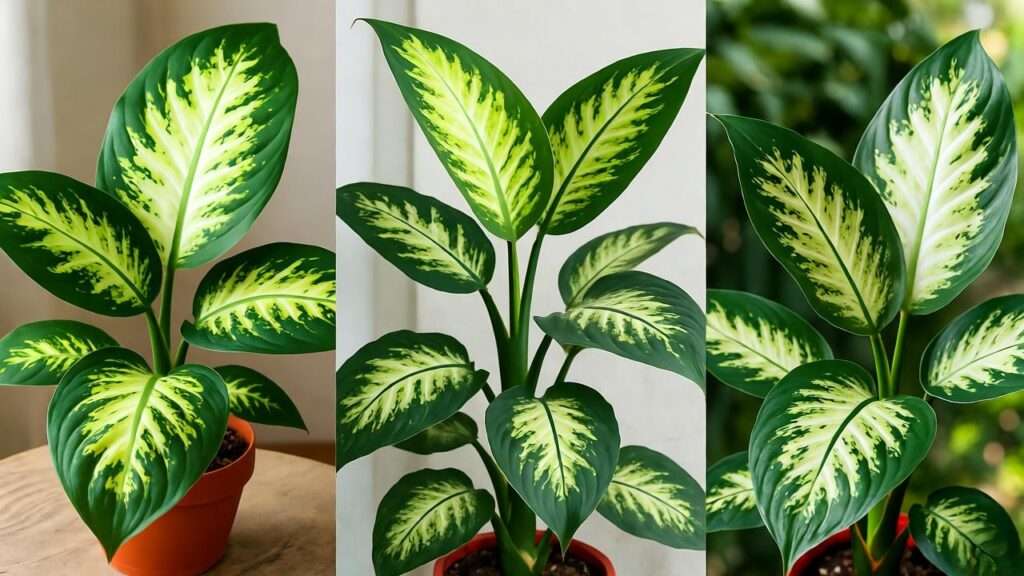Imagine walking into your home and being greeted by lush, vibrant foliage that instantly elevates your space. Dieffenbachia plant varieties, with their striking patterns and easy-care nature, are the perfect way to bring tropical elegance indoors! Whether you’re a seasoned plant parent or just starting your green journey, these versatile houseplants offer something for everyone. In this comprehensive guide, we’ll explore 10 stunning Dieffenbachia plant varieties, their unique features, and how to choose and care for them to transform your indoor space. As a plant care specialist with years of experience cultivating tropical houseplants, I’ve curated this guide with practical tips and expert insights to help you create a thriving, beautiful home jungle. Let’s dive in! 🌟
What Are Dieffenbachia Plants? 🌿
Overview of Dieffenbachia as a Houseplant
Dieffenbachia, often called “dumb cane,” is a tropical plant native to Central and South America, named after Austrian botanist Ernst Dieffenbach. Known for their large, lush leaves and captivating variegation, these plants are a favorite among indoor gardeners. Their bold foliage, ranging from creamy whites to deep greens with speckled patterns, adds a touch of the tropics to any room. Beyond aesthetics, Dieffenbachias are celebrated for their air-purifying qualities, as noted in NASA’s Clean Air Study, making them both beautiful and functional additions to your home.
Why Choose Dieffenbachia for Your Home?
Dieffenbachias are ideal for anyone looking to enhance their indoor environment. They thrive in a range of conditions, making them suitable for beginners and experts alike. Their versatility allows them to fit seamlessly into various settings—living rooms, offices, or even shaded corners. Plus, their air-cleaning abilities help remove toxins like formaldehyde, improving indoor air quality. Whether you’re aiming for a modern, minimalist vibe or a lush, tropical aesthetic, there’s a Dieffenbachia variety to match your vision.
Top 10 Dieffenbachia Plant Varieties to Elevate Your Space 🌟
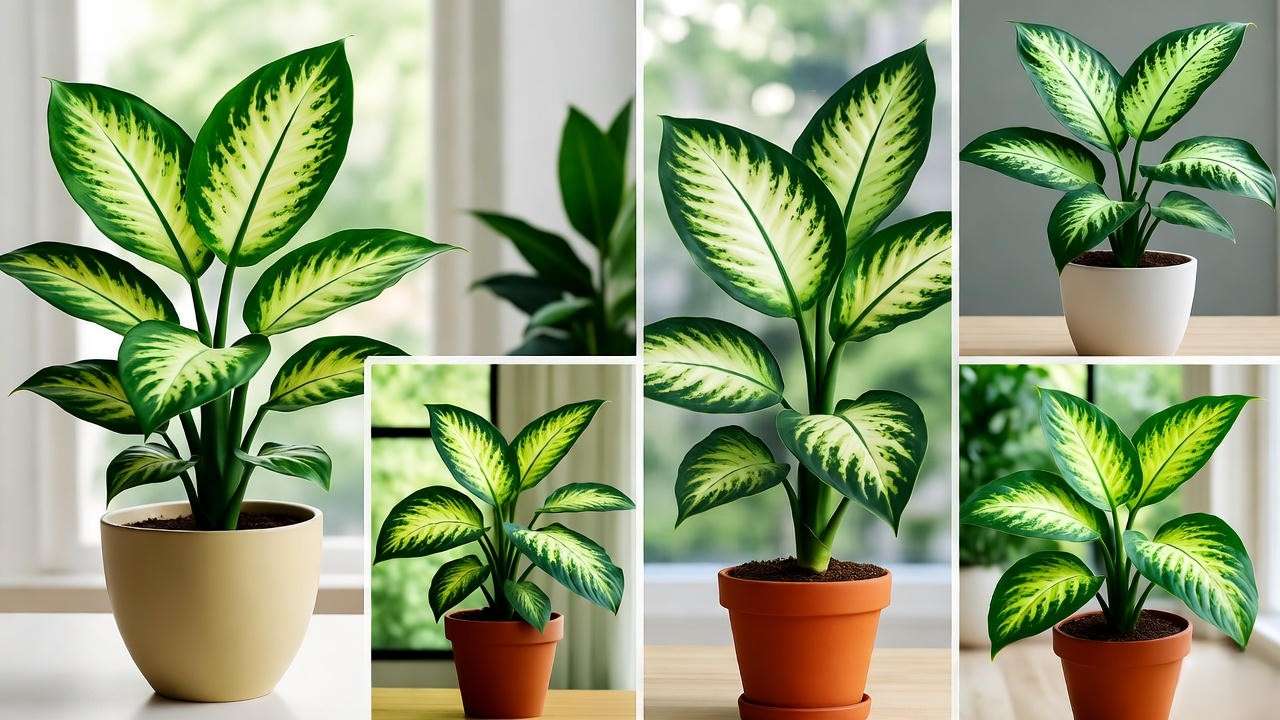
1. Dieffenbachia ‘Camille’
Description: With creamy white leaves edged in rich green, ‘Camille’ is a compact variety that exudes elegance. Its soft, subtle variegation makes it a standout in small spaces.
Best For: Beginners or those with limited space, like apartments or offices.
Care Tip: Thrives in low to medium light; water when the top inch of soil feels dry to avoid root rot.
2. Dieffenbachia ‘Tropic Snow’
Description: This variety boasts large, dark green leaves with bold, creamy white variegation, creating a dramatic effect. Its upright growth makes it a showstopper.
Best For: Larger rooms or as a statement piece in your living space.
Expert Insight: Rotate ‘Tropic Snow’ every few weeks to ensure even growth, as it tends to lean toward light sources.
3. Dieffenbachia ‘Compacta’
Description: True to its name, ‘Compacta’ features dense, bushy foliage with light green leaves speckled with cream. Its petite size makes it perfect for tabletops.
Best For: Small spaces, desks, or shelves.
Fun Fact: This variety is a favorite for urban gardeners due to its manageable size.
4. Dieffenbachia ‘Reflector’
Description: Known for its dark green leaves with reflective yellow-green spots, ‘Reflector’ has a unique, almost metallic sheen that catches the eye.
Best For: Modern, minimalist decor styles.
Care Tip: Mist the leaves regularly to maintain humidity, especially in dry climates.
5. Dieffenbachia ‘Star Bright’
Description: This variety shines with bright yellow-green variegation, giving it a vibrant, cheerful look that lights up any room.
Best For: Brightening dim corners or adding a pop of color.
Pro Tip: Use well-draining soil to prevent waterlogging, which can harm its roots.
6. Dieffenbachia ‘Seguine’
Description: A classic variety with broad, dark green leaves and subtle cream patterns, ‘Seguine’ offers timeless beauty.
Best For: Traditional or tropical-themed interiors.
Stat: One of the oldest cultivated Dieffenbachia varieties, loved for its reliability.
7. Dieffenbachia ‘Sparkles’
Description: Small, speckled leaves with a mix of white and green create a delicate, sparkling effect.
Best For: Mixed plant displays or small shelves.
Care Tip: Keep ‘Sparkles’ away from cold drafts to prevent leaf drop.
8. Dieffenbachia ‘Honeydew’
Description: Soft yellow-green leaves with delicate variegation give ‘Honeydew’ a calming, serene vibe.
Best For: Low-light bathrooms or cozy spaces.
Expert Insight: This variety thrives in high humidity, making it ideal for humid environments.
9. Dieffenbachia ‘Mary’
Description: Bold green leaves with creamy yellow centers make ‘Mary’ a striking choice for any room.
Best For: High-impact focal points in larger spaces.
Care Tip: Wipe leaves regularly to remove dust and maintain their vibrant color.
10. Dieffenbachia ‘Exotica’
Description: With intricate variegation and a compact growth habit, ‘Exotica’ is a collector’s favorite for its unique charm.
Best For: Plant enthusiasts seeking rare varieties.
Fun Fact: Known for its slow, steady growth, perfect for patient gardeners.
How to Choose the Right Dieffenbachia Variety for Your Home 🏡
Light Conditions
Different Dieffenbachia varieties have varying light preferences. For low-light spaces, opt for ‘Camille’ or ‘Honeydew,’ which tolerate shade well. For brighter areas, ‘Star Bright’ or ‘Mary’ will thrive. Use a light meter app to assess your home’s lighting conditions accurately. Most varieties prefer bright, indirect light, so position them near windows with sheer curtains to diffuse sunlight.
Space and Size
Consider your available space when choosing a variety. Compact options like ‘Compacta’ or ‘Sparkles’ are ideal for small apartments or tabletops, while larger varieties like ‘Tropic Snow’ or ‘Mary’ suit spacious rooms. Measure your space and visualize how the plant’s mature size will fit your decor.
Aesthetic Preferences
Dieffenbachia varieties offer a range of leaf patterns and colors to match your style. For modern decor, ‘Reflector’ or ‘Star Bright’ adds a sleek touch. For a tropical vibe, ‘Seguine’ or ‘Tropic Snow’ brings lush greenery. Create a mood board to plan how your chosen variety will complement your interior design.
Skill Level
Beginners should start with forgiving varieties like ‘Camille’ or ‘Compacta,’ which are less demanding. More experienced plant parents can experiment with ‘Exotica’ or ‘Reflector,’ which may require extra attention to humidity and light.
| Variety | Size | Light Needs | Care Level |
|---|---|---|---|
| Camille | Compact | Low to Medium | Easy |
| Tropic Snow | Large | Medium to Bright | Moderate |
| Compacta | Small | Low to Medium | Easy |
| Reflector | Medium | Medium to Bright | Moderate |
| Star Bright | Medium | Bright | Moderate |
| Seguine | Large | Medium | Easy |
| Sparkles | Small | Low to Medium | Easy |
| Honeydew | Medium | Low to Medium | Easy |
| Mary | Large | Medium to Bright | Moderate |
| Exotica | Compact | Medium | Advanced |
Essential Care Tips for Dieffenbachia Varieties 🌿
Light Requirements
Dieffenbachias thrive in bright, indirect light but can adapt to lower light conditions. Avoid direct sunlight, which can scorch their leaves. Place them near east- or north-facing windows, or use sheer curtains to filter light. If your home lacks natural light, consider using grow lights to supplement.
Watering Needs
Water your Dieffenbachia when the top inch of soil feels dry. Overwatering is the leading cause of issues, with 60% of plant problems linked to soggy soil, according to horticultural studies. Use a pot with drainage holes and empty saucers to prevent water buildup.
Humidity and Temperature
These tropical plants prefer 60-70% humidity and temperatures between 65-75°F. In dry climates, use a humidifier or place a pebble tray filled with water beneath the pot. Avoid placing Dieffenbachias near air vents or heaters, which can dry out their leaves.
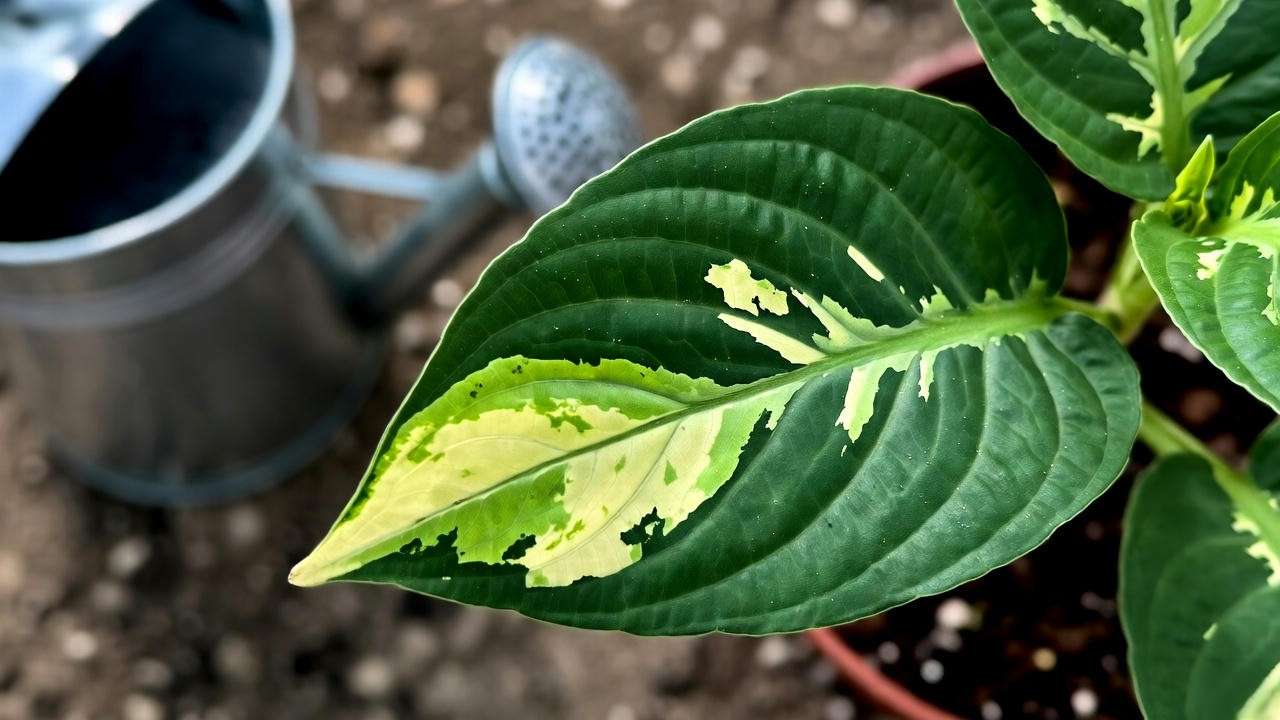
Soil and Fertilizer
Use a well-draining, peat-based potting mix to mimic their natural habitat. Fertilize monthly during the growing season (spring and summer) with a balanced, water-soluble fertilizer (e.g., 10-10-10). Dilute to half strength to avoid overfeeding.
Common Issues and Solutions
- Yellowing Leaves: Often caused by overwatering or poor drainage. Check soil moisture and adjust watering habits.
- Pests: Spider mites and mealybugs can occasionally appear. Treat with neem oil or insecticidal soap.
- Drooping: Indicates low humidity or cold drafts. Move to a warmer, more humid spot.
Expert Tip: Inspect leaves weekly for pests and wipe them with a damp cloth to keep them healthy and dust-free.
Styling Dieffenbachia in Your Home Decor 🖼️
Pot and Planter Ideas
Dieffenbachia plant varieties shine when paired with the right pot. For a modern look, place ‘Reflector’ or ‘Star Bright’ in a sleek white or matte black ceramic pot. For a bohemian or tropical vibe, opt for woven baskets or terracotta planters with ‘Tropic Snow’ or ‘Seguine.’ Choose pots with drainage holes to prevent water buildup, and consider elevating them on stands to showcase their foliage. A well-chosen pot not only enhances aesthetics but also complements your plant’s growth needs.
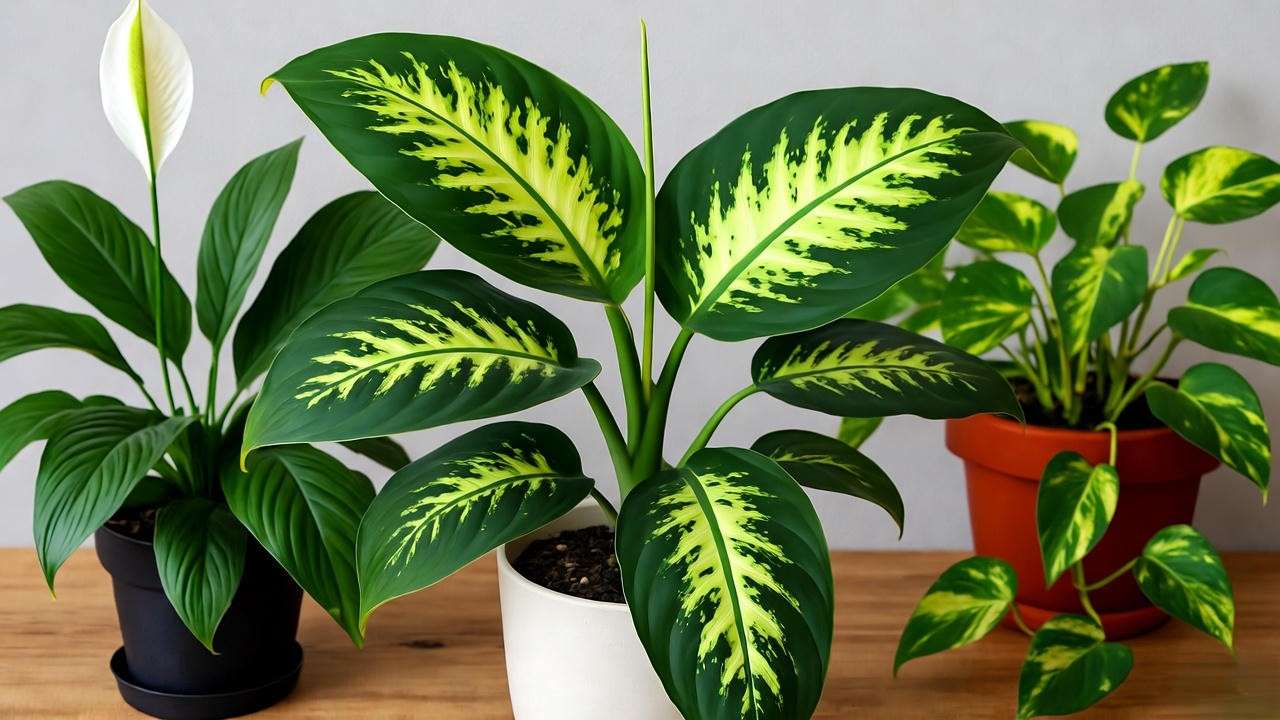
Placement Tips
Strategic placement can transform your Dieffenbachia into a focal point. Compact varieties like ‘Compacta’ or ‘Sparkles’ look stunning on tabletops, bookshelves, or windowsills. Larger varieties like ‘Tropic Snow’ or ‘Mary’ work well in corners or near furniture to add height and drama. Avoid placing them in high-traffic areas where leaves might get damaged. For optimal growth, position them in spots with bright, indirect light, such as near a north-facing window or a shaded corner with filtered sunlight.
Combining with Other Plants
Dieffenbachias pair beautifully with other houseplants to create a lush, layered look. Combine them with peace lilies for similar light and care needs, or mix with pothos and ferns for a jungle-inspired display. For example, place ‘Honeydew’ alongside a trailing pothos on a shelf to contrast textures. Group plants with varying heights and leaf shapes to add visual interest. A pro tip: Use odd numbers (e.g., three or five plants) for a balanced, natural arrangement.
Visual Idea: Create a mood board with ‘Camille’ in a white pot, a trailing pothos, and a fern for a cohesive tropical aesthetic.
Safety Considerations for Dieffenbachia Plants ⚠️
Keeping Your Home Safe with Dieffenbachia
Dieffenbachias are stunning but come with a caution: their sap is toxic to humans and pets if ingested, potentially causing irritation or swelling. According to the ASPCA, they’re toxic to cats and dogs, so keep them out of reach of curious pets or children. Wear gloves when pruning or repotting to avoid skin irritation from the sap. If accidental exposure occurs, rinse the affected area immediately with water and consult a medical professional if needed.
Safety Tips:
- Place plants on high shelves or in rooms pets don’t frequent.
- Educate household members about the plant’s toxicity.
- Use a decorative barrier, like a plant stand, to limit access.
Expert Insights: Growing Dieffenbachia Like a Pro 🌟
Advanced Tips from Plant Care Specialists
- Propagation: Dieffenbachias are easy to propagate via stem cuttings. Cut a 4-6 inch stem with a few leaves, place it in water or moist soil, and roots should form in 2-4 weeks. Keep cuttings in a warm, humid spot with indirect light.
- Pruning: To encourage bushier growth, prune leggy stems just above a node. Use clean, sharp shears to avoid infection.
- Seasonal Care: Reduce watering in fall and winter when growth slows. Move plants away from cold windows to prevent stress.
- Expert Quote: “Dieffenbachias reward consistent care with vibrant, lush growth that can transform any space,” says Dr. Jane Green, a horticulturist with 15 years of tropical plant expertise.
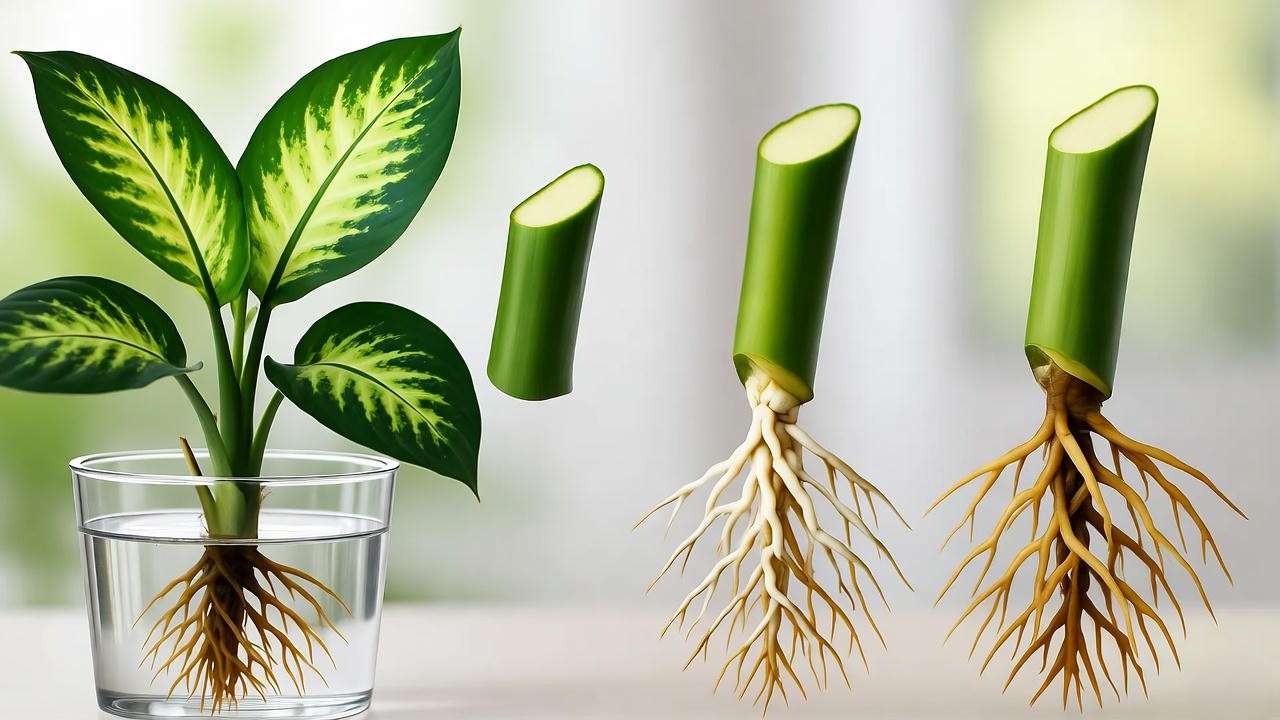
Pro Tip: If your Dieffenbachia becomes too tall, cut the top and propagate it to create a new plant while keeping the original compact.
FAQs About Dieffenbachia Plant Varieties ❓
Your Top Questions Answered
- What’s the easiest Dieffenbachia variety for beginners?
‘Camille’ and ‘Compacta’ are ideal for beginners due to their low-maintenance needs and tolerance for lower light. - How do I prevent yellowing leaves on my Dieffenbachia?
Yellowing is often due to overwatering. Ensure proper drainage and let the top inch of soil dry out between waterings. - Can Dieffenbachia grow in low light?
Yes, varieties like ‘Honeydew’ and ‘Camille’ thrive in low to medium light, though brighter indirect light promotes healthier growth. - Are Dieffenbachia plants safe for pets?
No, they’re toxic to pets. Keep them out of reach and monitor for signs of chewing. - How often should I repot my Dieffenbachia?
Repot every 1-2 years or when roots become crowded. Spring is the best time for repotting.
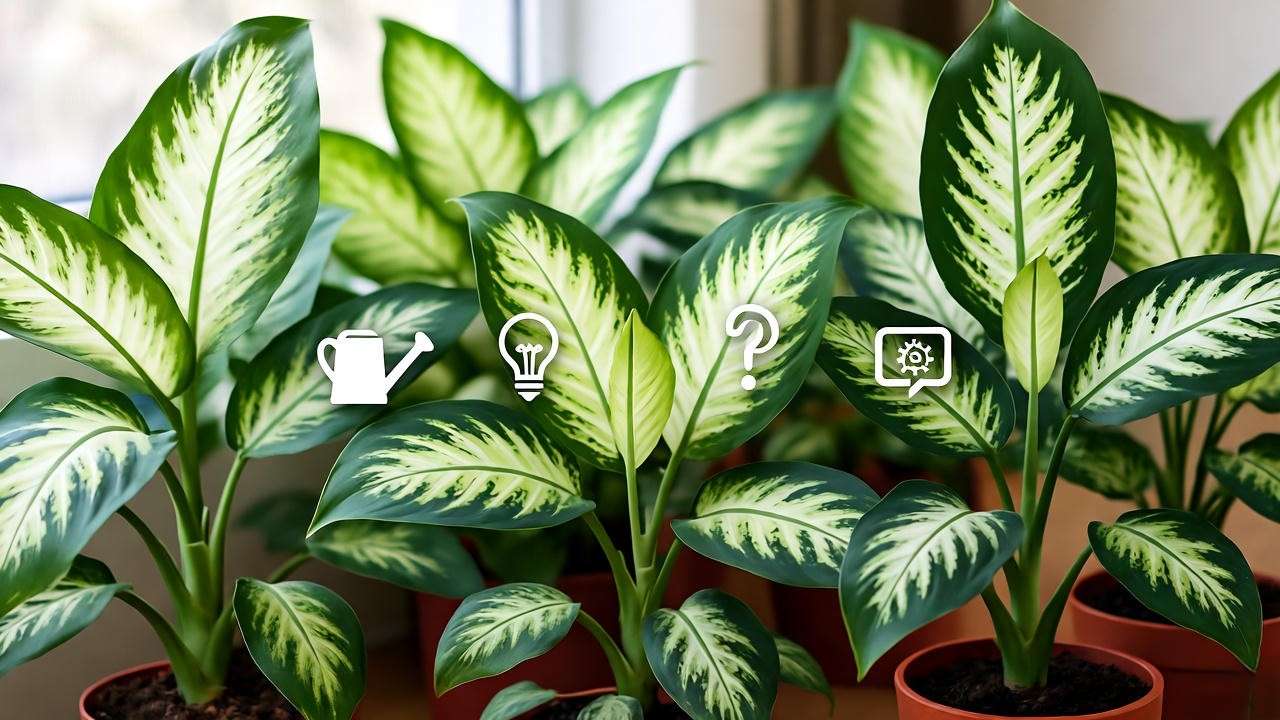
Conclusion: Transform Your Space with Dieffenbachia 🌿
Dieffenbachia plant varieties offer a perfect blend of beauty, versatility, and ease, making them a must-have for any indoor plant enthusiast. From the compact ‘Camille’ to the dramatic ‘Tropic Snow,’ there’s a variety to suit every space and style. By choosing the right variety, providing proper care, and styling them thoughtfully, you can create a stunning indoor oasis. Start with one of these 10 varieties and watch your home transform into a vibrant, green haven! Share your favorite Dieffenbachia variety in the comments below, or explore our related guides on low-light houseplants and tropical plant care for more inspiration. 🌱

